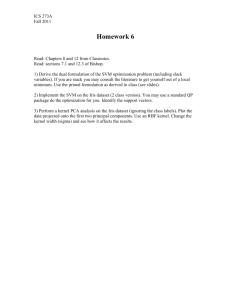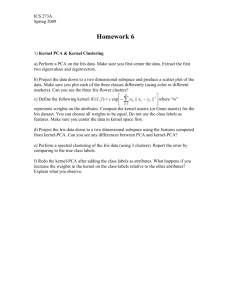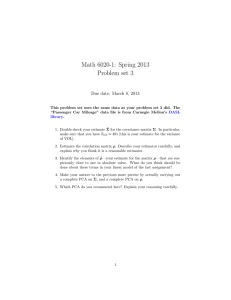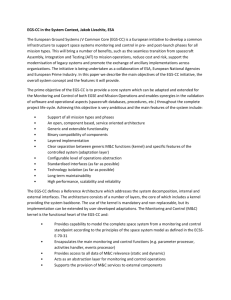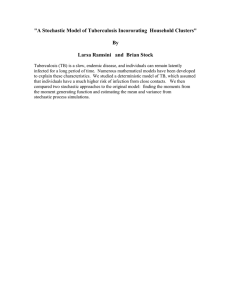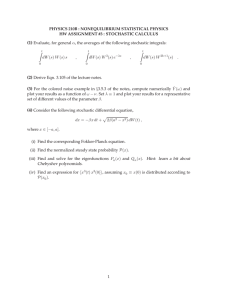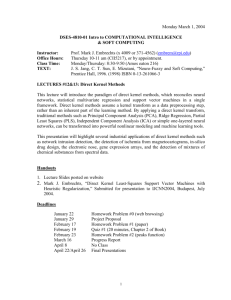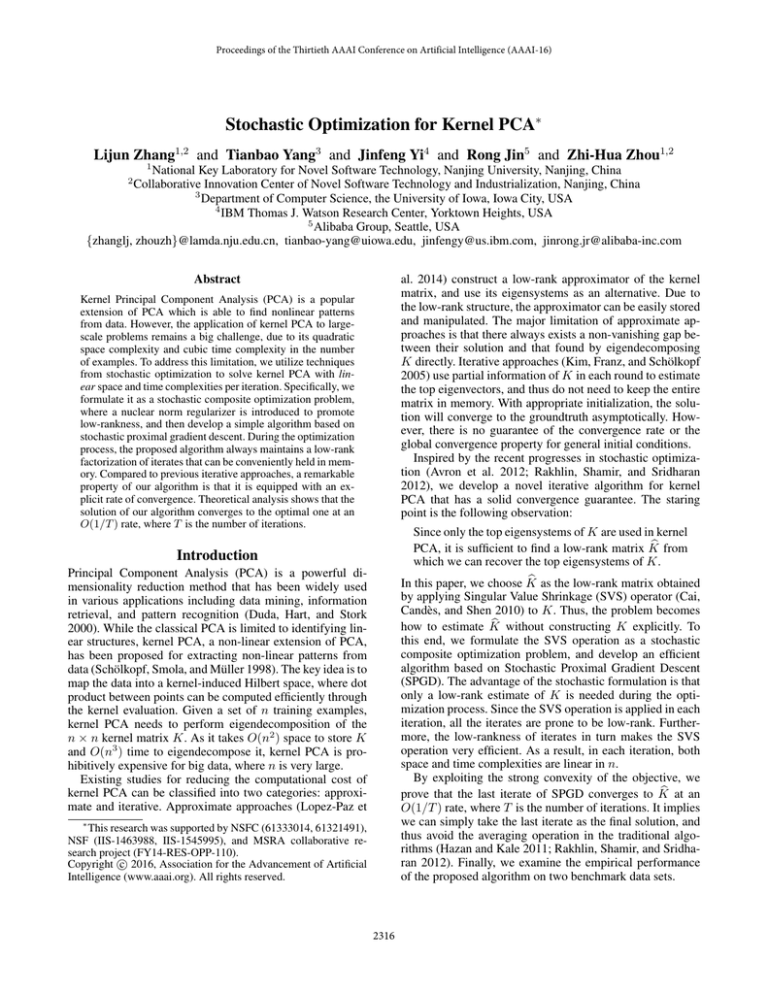
Proceedings of the Thirtieth AAAI Conference on Artificial Intelligence (AAAI-16)
Stochastic Optimization for Kernel PCA∗
Lijun Zhang1,2 and Tianbao Yang3 and Jinfeng Yi4 and Rong Jin5 and Zhi-Hua Zhou1,2
1
National Key Laboratory for Novel Software Technology, Nanjing University, Nanjing, China
Collaborative Innovation Center of Novel Software Technology and Industrialization, Nanjing, China
3
Department of Computer Science, the University of Iowa, Iowa City, USA
4
IBM Thomas J. Watson Research Center, Yorktown Heights, USA
5
Alibaba Group, Seattle, USA
{zhanglj, zhouzh}@lamda.nju.edu.cn, tianbao-yang@uiowa.edu, jinfengy@us.ibm.com, jinrong.jr@alibaba-inc.com
2
al. 2014) construct a low-rank approximator of the kernel
matrix, and use its eigensystems as an alternative. Due to
the low-rank structure, the approximator can be easily stored
and manipulated. The major limitation of approximate approaches is that there always exists a non-vanishing gap between their solution and that found by eigendecomposing
K directly. Iterative approaches (Kim, Franz, and Schölkopf
2005) use partial information of K in each round to estimate
the top eigenvectors, and thus do not need to keep the entire
matrix in memory. With appropriate initialization, the solution will converge to the groundtruth asymptotically. However, there is no guarantee of the convergence rate or the
global convergence property for general initial conditions.
Inspired by the recent progresses in stochastic optimization (Avron et al. 2012; Rakhlin, Shamir, and Sridharan
2012), we develop a novel iterative algorithm for kernel
PCA that has a solid convergence guarantee. The staring
point is the following observation:
Abstract
Kernel Principal Component Analysis (PCA) is a popular
extension of PCA which is able to find nonlinear patterns
from data. However, the application of kernel PCA to largescale problems remains a big challenge, due to its quadratic
space complexity and cubic time complexity in the number
of examples. To address this limitation, we utilize techniques
from stochastic optimization to solve kernel PCA with linear space and time complexities per iteration. Specifically, we
formulate it as a stochastic composite optimization problem,
where a nuclear norm regularizer is introduced to promote
low-rankness, and then develop a simple algorithm based on
stochastic proximal gradient descent. During the optimization
process, the proposed algorithm always maintains a low-rank
factorization of iterates that can be conveniently held in memory. Compared to previous iterative approaches, a remarkable
property of our algorithm is that it is equipped with an explicit rate of convergence. Theoretical analysis shows that the
solution of our algorithm converges to the optimal one at an
O(1/T ) rate, where T is the number of iterations.
Since only the top eigensystems of K are used in kernel
from
PCA, it is sufficient to find a low-rank matrix K
which we can recover the top eigensystems of K.
as the low-rank matrix obtained
In this paper, we choose K
by applying Singular Value Shrinkage (SVS) operator (Cai,
Candès, and Shen 2010) to K. Thus, the problem becomes
without constructing K explicitly. To
how to estimate K
this end, we formulate the SVS operation as a stochastic
composite optimization problem, and develop an efficient
algorithm based on Stochastic Proximal Gradient Descent
(SPGD). The advantage of the stochastic formulation is that
only a low-rank estimate of K is needed during the optimization process. Since the SVS operation is applied in each
iteration, all the iterates are prone to be low-rank. Furthermore, the low-rankness of iterates in turn makes the SVS
operation very efficient. As a result, in each iteration, both
space and time complexities are linear in n.
By exploiting the strong convexity of the objective, we
at an
prove that the last iterate of SPGD converges to K
O(1/T ) rate, where T is the number of iterations. It implies
we can simply take the last iterate as the final solution, and
thus avoid the averaging operation in the traditional algorithms (Hazan and Kale 2011; Rakhlin, Shamir, and Sridharan 2012). Finally, we examine the empirical performance
of the proposed algorithm on two benchmark data sets.
Introduction
Principal Component Analysis (PCA) is a powerful dimensionality reduction method that has been widely used
in various applications including data mining, information
retrieval, and pattern recognition (Duda, Hart, and Stork
2000). While the classical PCA is limited to identifying linear structures, kernel PCA, a non-linear extension of PCA,
has been proposed for extracting non-linear patterns from
data (Schölkopf, Smola, and Müller 1998). The key idea is to
map the data into a kernel-induced Hilbert space, where dot
product between points can be computed efficiently through
the kernel evaluation. Given a set of n training examples,
kernel PCA needs to perform eigendecomposition of the
n × n kernel matrix K. As it takes O(n2 ) space to store K
and O(n3 ) time to eigendecompose it, kernel PCA is prohibitively expensive for big data, where n is very large.
Existing studies for reducing the computational cost of
kernel PCA can be classified into two categories: approximate and iterative. Approximate approaches (Lopez-Paz et
∗
This research was supported by NSFC (61333014, 61321491),
NSF (IIS-1463988, IIS-1545995), and MSRA collaborative research project (FY14-RES-OPP-110).
c 2016, Association for the Advancement of Artificial
Copyright Intelligence (www.aaai.org). All rights reserved.
2316
Related Work
that aim to reduce its cost in testing. In particular, sparse
kernel PCA (Tipping 2001) has been proposed to express
each eigenvector vi in terms of a small number of training
examples. It was later extended to online setting (Honeine
2012), where training examples arrive sequentially.
Finally, we note that it is always possible to cast the problem of kernel PCA as a special case of linear PCA, which
can be solved efficiently by online algorithms designed for
linear PCA. To do this, we simply treat columns of K as
feature vectors, evaluate them sequentially, and pass them to
online algorithms for linear PCA. In this way, we can find
the top eigensystems of K 2 , from which we can derive the
top eigensystems of K. However, this kind of approaches
suffers from one of the following limitations.
1. Some online PCA algorithms, such as the generalized
Hebbian algorithm, are only able to find top eigenvectors.
But for kernel PCA, we need both top eigenvectors and
eigenvalues.
2. Many online algorithms for linear PCA, such as capped
MSG (Arora, Cotter, and Srebro 2013) and incremental
SVD (Brand 2006), lack formal theoretical guarantees.
3. Although certain online algorithms are equipped with regret bounds (Warmuth and Kuzmin 2008), the difference
between the eigenvectors returned by online algorithms
and the ground-truth remains unclear.
In this section, we briefly review the related work on kernel
PCA and stochastic optimization.
Kernel PCA
The basic idea of kernel PCA is to map the input data into
a Reproducing Kernel Hilbert Space (RKHS) induced by a
kernel function, and perform PCA in that space (Schölkopf,
Smola, and Müller 1998). Let H be a RKHS with a kernel function κ(x, y) = φ(x) φ(y), ∀x, y ∈ Rd , where
φ : Rd → H is a possibly nonlinear feature mapping. For
the sake of simplicity, we assume the data are centered, i.e.,
n
i=1 φ(x
ni ) = 0. The covariance matrix in H is given by
C = n1 i=1 φ(xi )φ(xi ) . We now have to find the eigenvalues λ ≥ 0 and eigenvectors v ∈ H \ {0} satisfying
Cv = λv. Since all solutions v with λ = 0 lie within the
span of φ(x1 ), . . . , φ(xn ), we can represent v as v = Φu,
where Φ = [φ(x1 ), . . . , φ(xn )] and u ∈ Rn . As a result, it
is equivalent to consider the following problem
1
ΦΦ Φu = λΦu.
(1)
n
Let K ∈ Rn×n be the kernel matrix with Kij = κ(xi , xj )
for i, j = 1 . . . , n. Multiplying both sides of (1) by Φ , we
obtain K 2 u = λnKu, which can be simplified to the eigenvalue problem Ku = λnu (Schölkopf, Smola, and Müller
1998, Appendix A). Let (ui , λi ) be the i-th eigenvector and
eigenvalue pair of K, with normalization λi ui 22 = 1.
Then, the i-th eigenvector of C is given by vi = Φui , which
has unit length as indicated below
Stochastic Optimization
Stochastic optimization refers to the setting where we can
only access to the stochastic gradient of the objective function (Hazan and Kale 2011; Zhang, Mahdavi, and Jin
2013). For general Lipschitz continuous convex functions,
Stochastic√
Gradient Descent (SGD) exhibits the unimprovable O(1/ T ) rate of convergence (Nemirovski and Yudin
1983). For strongly convex functions, some variants of
SGD (Hazan and Kale 2011; Rakhlin, Shamir, and Sridharan 2012; Zhang et al. 2013) achieve the optimal O(1/T )
rate (Agarwal et al. 2012).
Recently, a special case of stochastic optimization,
namely Stochastic Composite Optimization (SCO), has received significant interest in optimization and learning communities (Ghadimi and Lan 2012; Lin, Chen, and Peña 2014;
Zhang et al. 2014). In SCO, the objective function is given
by the summation of non-smooth and smooth stochastic
components (Lan 2012). The most popular non-smooth
components are the 1 -norm regularizer for vectors and the
nuclear norm regularizer for matrices, which enforce sparseness and low-rankness, respectively. Although the generic
algorithms designed for stochastic optimization can also be
applied to SCO, by replacing gradient with subgradient, they
can not utilize the structure of the objective function to generate sparse or low-rank intermediate solutions. The specialized algorithms for SCO are all built upon Stochastic
Proximal Gradient Descent (SPGD), where the power of the
non-smooth term is preserved (Lan 2012; Ghadimi and Lan
2012; Chen, Lin, and Peña 2012; Lin, Chen, and Peña 2014).
A major limitation of existing algorithms for SCO is that
they did not treat memory as a limited resource. If we apply them to the SCO problem considered in this paper, the
2
vi vi = u
i Φ Φui = ui Kui = λi ui 2 = 1.
Generally speaking, it takes O(dn2 ) time to calculate
K, O(n2 ) space to store, and O(n3 ) time to eigendecompose it. Thus, the vanilla procedure described above becomes computationally expensive when n is large. Approximate approaches for kernel PCA (Achlioptas, Mcsherry, and Schölkopf 2002; Ouimet and Bengio 2005;
Zhang, Tsang, and Kwok 2008; Lopez-Paz et al. 2014)
adopt matrix approximation techniques, such as the Nyström
method (Williams and Seeger 2001; Drineas and Mahoney
2005), to construct a low-rank approximator of K, and then
perform eigendecomposition of this low-rank matrix. For
approximate approaches, there is a dilemma between the
space complexity and the accuracy of their solution. The
smaller the memory, the larger the approximation error, and
vice visa. On the other hand, iterative approaches can find an
accurate solution with a small memory, at the cost of a longer
time. The most popular iterative approach for kernel PCA
is the Kernel Hebbian Algorithm (KHA) (Kim, Franz, and
Schölkopf 2005; Günter, Schraudolph, and Vishwanathan
2007), which is a kernelized version of the generalized
Hebbian algorithm designed for linear PCA (Oja 1982;
Sanger 1989). Similar to the algorithm proposed here, KHA
is also a stochastic approximation algorithm. However, due
to the non-convexity of its formulation, there is no global
convergence guarantee for KHA.
While the work referenced above focus on reducing the
cost of kernel PCA during training, there are some studies
2317
memory complexity is still O(n2 ). We do find a heuristic algorithm (Avron et al. 2012) in the literature which combines
truncated SVD with SGD to control the space complexity.
But it relies on the assumption that the objective value can
be evaluated easily, which unfortunately does not hold in our
case. That is the reason why we choose the basic SPGD instead of more advanced methods to optimize our problem
and establish a novel convergence guarantee for SPGD.
is an unbiased estimate of K with rank at most k. If a
symmetric matrix is desired, we can set
⎛
⎞
k
k
n ⎝
⎠
K∗ij e
eij K∗i
ξ=
ij +
j
2k j=1
j=1
which is an unbiased estimate of K with rank at most 2k.
2. When the kernel matrix K is generated by a shiftinvariant kernel, such as the Gaussian kernel and the
Laplacian kernel. We can construct ξ by the random
Fourier features (Rahimi and Recht 2008). Let κ(x, y) be
the shift-invariant kernel with Fourier representation
κ(x, y) = p(w) exp(jw (x − y))dw
Algorithm
We first formulate kernel PCA as a SCO problem, then develop the optimization algorithm, next discuss implementation issues, and finally present the theoretical guarantee.
Reformulation of Kernel PCA
where p(w) is a density function. Let w be a Fourier component randomly sampled from p(w), and let a(w) and
b(w) be the feature vectors generated by w, i.e.,
Denote the eigendecomposition of the kernel matrix K by
U ΛU , where U = [u1 , . . . , un ], Λ = diag[λ1 , . . . , λn ],
and λ1 ≥ λ2 ≥ · · · λn . To train kernel PCA, it is sufficient to
from which the top eigensystems
find a low-rank matrix K
of K can be recovered. The ideal
klow-rank matrix would be
the truncated SVD of K, i.e., i=1 λi ui u
i for some integer k > 0. However, the truncated SVD operation is nonconvex, making it difficult to design a principled algorithm.
obtained by apInstead, we consider the low-rank matrix K
plying the Singular Value Shrinkage (SVS) operator to K
with threshold λ (Cai, Candès, and Shen 2010), 1 i.e.,
= Dλ [K] =
(λi − λ)ui u
K
i .
a(w) =[cos(w x1 ), . . . , cos(w xn )] ,
b(w) =[sin(w x1 ), . . . , sin(w xn )] .
By drawn k independent samples from p(w), denoted by
w1 , . . . , wk , we construct ξ as
ξ=
k
1
a(wi )a(wi ) + b(wi )b(wi )
k i=1
which is an unbiased estimate of K with rank at most 2k.
3. For dot product kernels such as the polynomial kernel,
we can generate the random matrix ξ in a similar way
(Kar and Karnick 2012).
Then, we rewrite Z − K2F in (2) as
i:λi >λ
From the above expression, we observe that eigenvectors of
with nonzero eigenvalues are the top eigenvectors of K.
K
are the top eigenFurthermore, nonzero eigenvalues of K
values of K minus λ. As a result, we can recover the top
eigensystems of K (with eigenvalues larger than λ) from the
eigendecomposition of K.
In the following, we formulate the SVS operation as a
is the optimal soSCO problem. First, it is well-known K
lution to the following convex composite optimization problem
1
Z − K2F + λZ∗
(2)
min
n×n
2
Z∈R
where · ∗ is the nuclear norm of matrices. Let ξ be a lowrank random matrix which is an unbiased estimate of K, i.e.,
K = E[ξ].
We list examples of such random matrices below.
1. For general kernel matrix K, we can construct ξ by sampling its rows or columns randomly. Let {i1 , . . . , ik } be a
set of random indices sampled from [n] uniformly, K∗ij
be the ij -th column of K, eij be the ij -th canonical base.
Then,
k
n
ξ=
K∗ij e
ij
k j=1
Z − K2F = Z2F − 2 tr(Z K) + K2F
=Z2F − 2 tr(Z E[ξ]) + E[ξ2F ] + K2F − E[ξ2F ]
=E Z − ξ2F + K2F − E[ξ2F ]
Since K2F − E[ξ2F ] is a constant term with respect to Z,
(2) is equivalent to
1 E Z − ξ2F + λZ∗
(3)
min
n×n
2
Z∈R
a standard SCO problem with a nuclear norm regularizer.
Optimization by Stochastic Proximal Gradient
Descent (SPGD)
At this point, one may consider applying existing algorithms
for stochastic optimization to the problem in (3). Unfortunately, we find that all the previous algorithms can not be
applied directly due to the high space complexity or unrealistic assumptions, as explained below.
1. The generic algorithms for stochastic optimization (Nemirovski et al. 2009; Hazan and Kale 2011; Rakhlin,
Shamir, and Sridharan 2012; Shamir and Zhang 2012) are
built up SGD, and thus cannot utilize the structure of (3)
to enforce low-rankness. Furthermore, those algorithms
return the average of iterates as the final solution, which
could be full-rank.
For a matrix X ∈ Rm×n with singular value decomposition U ΣV , where Σ = diag[σ1 , . . . , σmin(m,n) ],
Dλ [X]
and
is given by Dλ [X] = U Dλ [Σ]V
Dλ [Σ] =
diag max(0, σ1 − λ), . . . , max(0, σmin(m,n) − λ) .
1
2318
Algorithm 1 A Stochastic algorithm for Kernel PCA
Input: The number of trials T , and the regularization parameter λ
1: Initialize Z1 = 0
2: for t = 1, 2, . . . , T do
3:
Sample a random matrix ξt
4:
ηt = 2/t
5:
Zt+1 = Dηt λ [(1 − ηt )Zt + ηt ξt ]
6: end for
7: Calculate the nonzero eigensystems of 12 (ZT +1 +
ZT+1 ): {(ui , σi )}ki=1
8: return {(ui , σi + λ)}ki=1
2. Although the specialized algorithms for SCO can generate low-rank iterates based on SPGD, they need to
keep track of the averaged iterates as an auxiliary variable (Chen, Lin, and Peña 2012; Lin, Chen, and Peña
2014) or as the final solution (Lan 2012; Ghadimi and Lan
2012). Thus, the space complexity is still O(n2 ).
3. Although the heuristic algorithm in (Avron et al. 2012)
is able to make the space complexity linear in n, it needs
to evaluate the objective value in each iteration, which is
impossible for the SCO problem in (3). Furthermore, it
is designed for general SCO problems and thus cannot
exploit the strong convexity of (3).
Due to the above reasons, we develop a new algorithm to
optimize (3), which is purely based on SPGD and takes its
last iterate as the final solution. Denote by Zt the solution
at the t-th iteration. In this iteration, we first sample a random matrix ξt ∈ Rn×n , and it is easy to verify
that Zt − ξt
is an unbiased estimate of the gradient of 12 E Z − ξ2F .
Then, we update the current solution by the SPGD, which is
essentially a stochastic variant of composite gradient mapping (Nesterov 2013)
and 1n is a n-dimensional vector of all ones. If ξ is an unbiased estimate of K, then it is easy to verify ξ + θ where
1
1
1 1 n 1
ξ1n 1
(1n ξ1n )1n 1
n −
nξ −
n
2
n
n
n
is an unbiased estimate of K + Θ. To find the top eigensystems of K + Θ, we just need to replace the random matrix ξ
in our algorithm with ξ + θ and all the rest is the same.
θ=
Zt+1
1
= argmin Z − Zt 2F + ηt Z − Zt , Zt − ξt + ηt λZ∗
Z∈Rn×n 2
1
2
= argmin Z − [(1 − ηt )Zt + ηt ξt ]F + ηt λZ∗
2
n×n
Z∈R
Implementation Issues
In this section, we discuss how to ensure all the iterates are
represented in low-rank factorization form and how to accelerate the SVS operation by utilizing this fact.
First, the random matrices ξt can always be represented
n×at
by ξt = ζt χ
are two rectant , where ζt , χt ∈ R
gular matrices with at n. Now, suppose Zt is also
represented by Zt = Ut Vt , where Ut , Vt ∈ Rn×bt are
two rectangular
matrices with bt n.2 Then, Zt+1 =
Dηt λ (1 − ηt )Ut Vt + ηt ζt χ
can be solved efficiently
t
according to Lemma 3.4 of (Avron et al. 2012). Specifically,
we introduce two matrices Xt , Yt ∈ Rn×(at +bt ) such that
√
Xt =[ 1 − ηt Ut , ηt ζt ],
√
Yt =[ 1 − ηt Vt , ηt χt ], and Zt+1 = Dηt λ [Xt Yt ].
=Dηt λ [(1 − ηt )Zt + ηt ξt ]
= (1 − ηt )Zt + ηt ξt .
where ηt > 0 is the step size. Let Zt+1
The SVS operation applies a soft-thresholding rule to the
singular values of Zt+1
, effectively shrinking them toward
zero. In particular, singular values of Zt+1
that are below
the threshold ηt λ vanish, and thus Zt+1 tends to be a lowrank matrix.
Let ZT +1 be the final solution obtained after T iterations.
If ZT +1 is symmetric, we will eigendecompose ZT +1 and
obtain its eigensystems {(ui , σi )}ki=1 with nonzero eigenvalues. Otherwise, we will use the eigensystems of (ZT +1 +
ZT+1 )/2 instead of ZT +1 . Note that (ZT +1 + ZT+1 )/2 is
than ZT +1 , since
symmetric and always more close to K
1
(ZT +1 + ZT+1 ) − K
2
F
1
1
F + Z
F
≤ ZT +1 − K
− K
2
2 T +1
F.
=ZT +1 − K
Next, we perform a reduced QR decomposition (Golub and
Van Loan 1996) of Xt = QX RX and Yt = QY RY , and
Σ
V . Define U
t = QX U
and
find the SVD of RX RY = U
Vt = QY V . It is easy to verify that Ut ΣVt is the SVD
of Xt Yt , from which Zt+1 can be calculated trivially, and
represented in the from of Zt+1 = Ut+1 Vt+1
.
From the above discussion, it is clear that the space complexity is O(n(at + bt )) in each iteration. The running time
is dominated by calculating ξt , which takes O(ndat ) time,
and QR decompositions, which take O(n(at + bt )2 ) time.
In summary, the time complexity is O(n[dat + (at + bt )2 ]).
Thus, both space and time complexities are linear in n.
Finally, we return {(ui , σi + λ)}ki=1 as the top eigensystems
of K. The above procedure is summarized in Algorithm 1.
Although we assume that data are centered in RKHS, our
algorithm can be immediately extend to the general case.
If data are uncentered, kernel PCA (Schölkopf, Smola, and
Müller 1998) needs the top eigensystems of K + Θ, where
Θ=
Theoretical Guarantee
The following theorem shows that with a high probability,
the optimal solution to (3), at an
ZT +1 converges to K,
O(1/T ) rate.
1 1
1
1 n 1
K1n 1
(1 K1n )1n 1
n −
nK −
n
n2 n
n
n
2
2319
At least, we can represent Z1 in this form since Z1 = 0.
The random matrix in SKPCA is constructed by random
Fourier features (Rahimi and Recht 2008). The experiments
are done on two benchmark data sets: Mushrooms (Chang
and Lin 2011) and Magic (Frank and Asuncion 2010),
which contain 8, 124 and 19, 020 examples, respectively. We
choose those two medium-size data sets, because they can be
handled by Baseline and thus allow us to compare different
methods quantitatively. For all the experiments, we repeat
them 10 times and report the averaged result.
Theorem 1 Assume the Frobenius norm of the random matrix ξ is upper bounded by some constant C > 0. By setting
ηt = 2/t, with a probability at least 1 − δ, we have
2
ZT +1 − K
F
√
2 log2 T 8
Cλ max rt + C 2 8 + 6 log
≤
T
δ
t∈[T ]
log log T
=O
T
Experimental Results
where rt is the rank of Zt .
Note that the O(1/T ) convergence rate matches the lowerbound of stochastic optimization of strongly convex functions (Agarwal et al. 2012). Our result differs from previous studies of SPGD (Rosasco, Villa, and Vũ 2014) in the
sense that we prove a high probability bound instead of
an expectation bound. Although a similar result has been
proved for SGD (Rakhlin, Shamir, and Sridharan 2012), this
is the first time such a guarantee is established for SPGD.
The proof of this theorem relies on the recent analysis of
SGD (Rakhlin, Shamir, and Sridharan 2012) and concentration inequalities (Bartlett, Bousquet, and Mendelson 2005;
Cesa-Bianchi and Lugosi 2006). Due to space limitations,
details are provided in the supplementary material.
We first examine the convergence rate of SKPCA. We run
SKPCA with four different combinations of the parameter λ and the number of random Fourier components k. In
Fig. 1(a), we report the normalized recover error Zt −
2 /n2 with respect to the number of iterations t on the
K
F
Mushrooms data set. For comparison, we also plot the curve
of 0.03/t. From the similarity among those curves, we believe the proposed algorithm achieves the O(1/T ) rate. As
can be seen, the two curves of k = 5 (or k = 50) almost
overlap with each other. That is probably because on this
data set λ is not the dominating term in the upper bound
given in Theorem 1. On the other hand, the convergence rate
highly depends on the number of Fourier components k. The
curves of k = 50 converge significantly faster than those of
k = 5. The reason is that the larger k is, the closer ξ and K
are, and the smaller the constant C in Theorem 1 is.
Then, we check the rank of the intermediate iterate Zt ,
denoted by rank(Zt ), which determines the computational
complexity of the t-th round. Fig. 1(b) plots rank(Zt ) as a
function of t, which first increases and then converges to cer is 158 when
tain constant. The rank of the target matrix K
λ = 1 and 55 when λ = 10. As can be seen, rank(Zt )
To compare
is just a constant factor larger than rank(K).
different methods, we use the top 50 eigensystems returned
by each algorithm to construct a rank-50 approximator of
K, denoted by K 50 , and report the approximation error
K 50 − KF /n in Fig. 1(c). In order to fit the figure, the
training time of Baseline was divided by 2. The result returned by Baseline is optimal, but it takes a longer time and
a much larger memory. Although Nyström is able to find
a good solution, it cannot further reduce the approximation
error. In comparison, SKPCA is able to refine its solution
continuously and outperforms Nyström after 10 seconds. Finally, we note that SKPCA is much faster than KHA.
Experimental results on the Magic data set are provided
in Fig. 2, which exhibits similar behaviors. On this data set,
is 89 when λ = 10 and 17 when λ = 100.
The rank of the K
The training time of Baseline was divided by 20 in Fig. 2(c).
Experiments
In this section, we perform several experiments to examine
the performance of our method.
Experimental Setting
We compare our stochastic algorithm for kernel PCA
(SKPCA) with the following methods.
1. Baseline (Schölkopf, Smola, and Müller 1998), which
calculates the kernel matrix K explicitly and eigendecomposes it.
2. Approximation based on the Nyström method (Drineas
and Mahoney 2005; Zhang, Tsang, and Kwok 2008),
which uses the Nyström method to find a low-rank approximator of K, and eigendecomposes it.
3. Kernel Hebbian Algorithm (KHA) (Kim, Franz, and
Schölkopf 2005), which is an iterative approach for kernel
PCA.
In order to run SKPCA, we need to decide the value of the
parameter λ in (3), which in turn determines the number of
eigenvectors used in kernel PCA. To minimize the generalization error, we would like to find a λ such that eigenvalues
of K that are smaller than it fall quickly (Shawe-Taylor et
al. 2005). However, it is infeasible to calculate eigenvalues
of K for large n, so we will use eigenvalues of a small kernel
matrix K of m examples to estimate λ. Note that eigenvalues of K/n and K/m both converges to those of the integral operator (Braun 2006). Although the optimal step size
of KHA in theory is 1/t, we found it led to very slow convergence, and thus set it to be 0.05 as suggested by (Kim,
Franz, and Schölkopf 2005).
We choose the Gaussian kernel κ(xi , xj ) = exp(xi −
xj 2 /(2σ 2 )), and set the kernel width σ to the 20-th percentile of the pairwise distances (Mallapragada et al. 2009).
Conclusions
In this paper, we have formulated kernel PCA as a stochastic
composite optimization problem with a nuclear norm regularizer, and then develop an iterative algorithm based on the
stochastic proximal gradient descent algorithm. The main
advantages of our method are i) both space and time complexes are linear in the number of samples; and ii) it is guaranteed to converge at an O(1/T ) rate, where T is the num-
2320
−3
x 10
λ=
λ=
λ=
λ=
0.03
t
2
0.06
0.05
Rank(Zt )
2 /n2
Zt − K
F
3
1, k = 5
1, k = 50
10, k = 5
10, k = 50
λ=
λ=
λ=
λ=
1, k = 5
1, k = 50
10, k = 5
10, k = 50
1
Approximation Error
4
50
100
t
150
200
2F /n2 versus t
(a) Zt − K
0.03
0.02
0.01
0
Basline (1/2)
Nystrom
KHA
SKPCA
0.04
t
0
(b) rank(Zt ) versus t
0
10
20
30
40
50
Training Time (s)
60
70
(c) Approximation error for K
Figure 1: Experimental Results on the Mushrooms data set. To fit the figure, the training time of Baseline was divided by 2 in
(c).
−3
x 10
λ=
λ=
λ=
λ=
0.05
t
0.05
150
2
1
0
200
Rank(Zt )
2 /n2
Zt − K
F
3
10, k = 5
10, k = 50
100, k = 5
100, k = 50
λ=
λ=
λ=
λ=
100
10, k = 5
10, k = 50
100, k = 5
100, k = 50
50
50
100
t
150
200
2F /n2 versus t
(a) Zt − K
Approximation Error
4
0.04
Basline (1/20)
Nystrom
KHA
SKPCA
0.03
0.02
0.01
50
100
t
150
(b) rank(Zt ) versus t
200
0
0
20
40
60
Training Time (s)
80
100
(c) Approximation error for K
Figure 2: Experimental Results on the Magic data set. To fit the figure, the training time of Baseline was divided by 20 in (c).
Local rademacher complexities. The Annals of Statistics
33(4):1497–1537.
Brand, M. 2006. Fast low-rank modifications of the thin
singular value decomposition. Linear Algebra and its Applications 415(1):20–30.
Braun, M. L. 2006. Accurate error bounds for the eigenvalues of the kernel matrix. Journal of Machine Learning
Research 7:2303–2328.
Cai, J.-F.; Candès, E. J.; and Shen, Z. 2010. A singular
value thresholding algorithm for matrix completion. SIAM
Journal on Optimization 20(4):1956–1982.
Cesa-Bianchi, N., and Lugosi, G. 2006. Prediction, Learning, and Games. Cambridge University Press.
Chang, C.-C., and Lin, C.-J. 2011. LIBSVM: A library for
support vector machines. ACM Transactions on Intelligent
Systems and Technology 2(3):27:1–27:27.
Chen, X.; Lin, Q.; and Peña, J. 2012. Optimal regularized
dual averaging methods for stochastic optimization. In Advances in Neural Information Processing Systems 25, 404–
412.
Drineas, P., and Mahoney, M. W. 2005. On the nyström
method for approximating a gram matrix for improved
ber of iterations. Experiments on two benchmark data sets
illustrate the efficiency and effectiveness of the proposed
method.
References
Achlioptas, D.; Mcsherry, F.; and Schölkopf, B. 2002. Sampling techniques for kernel methods. In Advances in Neural
Information Processing Systems 14, 335–342.
Agarwal, A.; Bartlett, P. L.; Ravikumar, P.; and Wainwright,
M. J. 2012. Information-theoretic lower bounds on the oracle complexity of stochastic convex optimization. IEEE
Transactions on Information Theory 58(5):3235–3249.
Arora, R.; Cotter, A.; and Srebro, N. 2013. Stochastic optimization of pca with capped msg. In Advances in Neural
Information Processing Systems 26, 1815–1823.
Avron, H.; Kale, S.; Kasiviswanathan, S.; and Sindhwani,
V. 2012. Efficient and practical stochastic subgradient descent for nuclear norm regularization. In Proceedings of the
29th International Conference on Machine Learning, 1231–
1238.
Bartlett, P. L.; Bousquet, O.; and Mendelson, S.
2005.
2321
kernel-based learning. Journal of Machine Learning Research 6:2153–2175.
Duda, R. O.; Hart, P. E.; and Stork, D. G. 2000. Pattern
Classification. Wiley-Interscience Publication.
Frank, A., and Asuncion, A. 2010. UCI machine learning
repository.
Ghadimi, S., and Lan, G. 2012. Optimal stochastic approximation algorithms for strongly convex stochastic composite optimization i: A generic algorithmic framework. SIAM
Journal on Optimization 22(4):1469–1492.
Golub, G. H., and Van Loan, C. F. 1996. Matrix computations, 3rd Edition. Johns Hopkins University Press.
Günter, S.; Schraudolph, N. N.; and Vishwanathan, S. V. N.
2007. Fast iterative kernel principal component analysis.
Journal of Machine Learning Research 8:1893–1918.
Hazan, E., and Kale, S. 2011. Beyond the regret minimization barrier: an optimal algorithm for stochastic stronglyconvex optimization. In Proceedings of the 24th Annual
Conference on Learning Theory, 421–436.
Honeine, P. 2012. Online kernel principal component analysis: A reduced-order model. IEEE Transactions on Pattern
Analysis and Machine Intelligence 34(9):1814–1826.
Kar, P., and Karnick, H. 2012. Random feature maps for
dot product kernels. In Proceedings of the 15th International Conference on Artificial Intelligence and Statistics,
583–591.
Kim, K. I.; Franz, M. O.; and Schölkopf, B. 2005. Iterative kernel principal component analysis for image modeling. IEEE Transactions on Pattern Analysis and Machine
Intelligence 27(9):1351–1366.
Lan, G. 2012. An optimal method for stochastic composite
optimization. Mathematical Programming 133:365–397.
Lin, Q.; Chen, X.; and Peña, J. 2014. A sparsity preserving
stochastic gradient methods for sparse regression. Computational Optimization and Applications 58(2):455–482.
Lopez-Paz, D.; Sra, S.; Smola, A. J.; Ghahramani, Z.; and
Schölkopf, B. 2014. Randomized nonlinear component
analysis. In Proceedings of the 31st International Conference on Machine Learning.
Mallapragada, P. K.; Jin, R.; Jain, A. K.; and Liu, Y. 2009.
Semiboost: Boosting for semi-supervised learning. IEEE
Transactions on Pattern Analysis and Machine Intelligence
31(11):2000–2014.
Nemirovski, A., and Yudin, D. B. 1983. Problem complexity
and method efficiency in optimization. John Wiley & Sons
Ltd.
Nemirovski, A.; Juditsky, A.; Lan, G.; and Shapiro, A. 2009.
Robust stochastic approximation approach to stochastic programming. SIAM Journal on Optimization 19(4):1574–
1609.
Nesterov, Y. 2013. Gradient methods for minimizing composite functions. Mathematical Programming 140(1):125–
161.
Oja, E. 1982. A simplified neuron model as a princi-
pal component analyzer. Journal of Mathematical Biology
15(3):267–273.
Ouimet, M., and Bengio, Y. 2005. Greedy spectral embedding. In Proceedings of the 10th International Workshop on
Artificial Intelligence and Statistics, 253–260.
Rahimi, A., and Recht, B. 2008. Random features for largescale kernel machines. In Advances in Neural Information
Processing Systems 20, 1177–1184.
Rakhlin, A.; Shamir, O.; and Sridharan, K. 2012. Making gradient descent optimal for strongly convex stochastic
optimization. In Proceedings of the 29th International Conference on Machine Learning, 449–456.
Rosasco, L.; Villa, S.; and Vũ, B. C. 2014. Convergence
of stochastic proximal gradient algorithm. ArXiv e-prints
arXiv:1403.5074.
Sanger, T. D. 1989. Optimal unsupervised learning in a
single-layer linear feedforward neural network. Neural Networks 2(6):459–473.
Schölkopf, B.; Smola, A.; and Müller, K.-R. 1998. Nonlinear component analysis as a kernel eigenvalue problem.
Neural Computation 10(5):1299–1319.
Shamir, O., and Zhang, T. 2012. Stochastic gradient descent
for non-smooth optimization: Convergence results and optimal averaging schemes. ArXiv e-prints arXiv:1212.1824.
Shawe-Taylor, J.; Williams, C. K. I.; Cristianini, N.; and
Kandola, J. 2005. On the eigenspectrum of the gram matrix
and the generalization error of kernel-pca. IEEE Transactions on Information Theory 51(7):2510–2522.
Tipping, M. E. 2001. Sparse kernel principal component
analysis. In Advances in Neural Information Processing Systems 13, 633–639.
Warmuth, M. K., and Kuzmin, D. 2008. Randomized online
pca algorithms with regret bounds that are logarithmic in the
dimension. Journal of Machine Learning Research 9:2287–
2320.
Williams, C., and Seeger, M. 2001. Using the nyström
method to speed up kernel machines. In Advances in Neural
Information Processing Systems 13, 682–688.
Zhang, L.; Yang, T.; Jin, R.; and He, X. 2013. O(log T ) projections for stochastic optimization of smooth and strongly
convex functions. In Proceedings of the 30th International
Conference on Machine Learning.
Zhang, W.; Zhang, L.; Hu, Y.; Jin, R.; Cai, D.; and He, X.
2014. Sparse learning for stochastic composite optimization.
In Proceedings of the 28th AAAI Conference on Artificial
Intelligence, 893–899.
Zhang, L.; Mahdavi, M.; and Jin, R. 2013. Linear convergence with condition number independent access of full gradients. In Advance in Neural Information Processing Systems 26, 980–988.
Zhang, K.; Tsang, I. W.; and Kwok, J. T. 2008. Improved
nyström low-rank approximation and error analysis. In Proceedings of the 25th International Conference on Machine
Learning, 1232–1239.
2322

